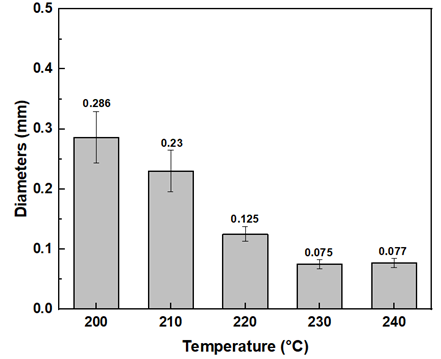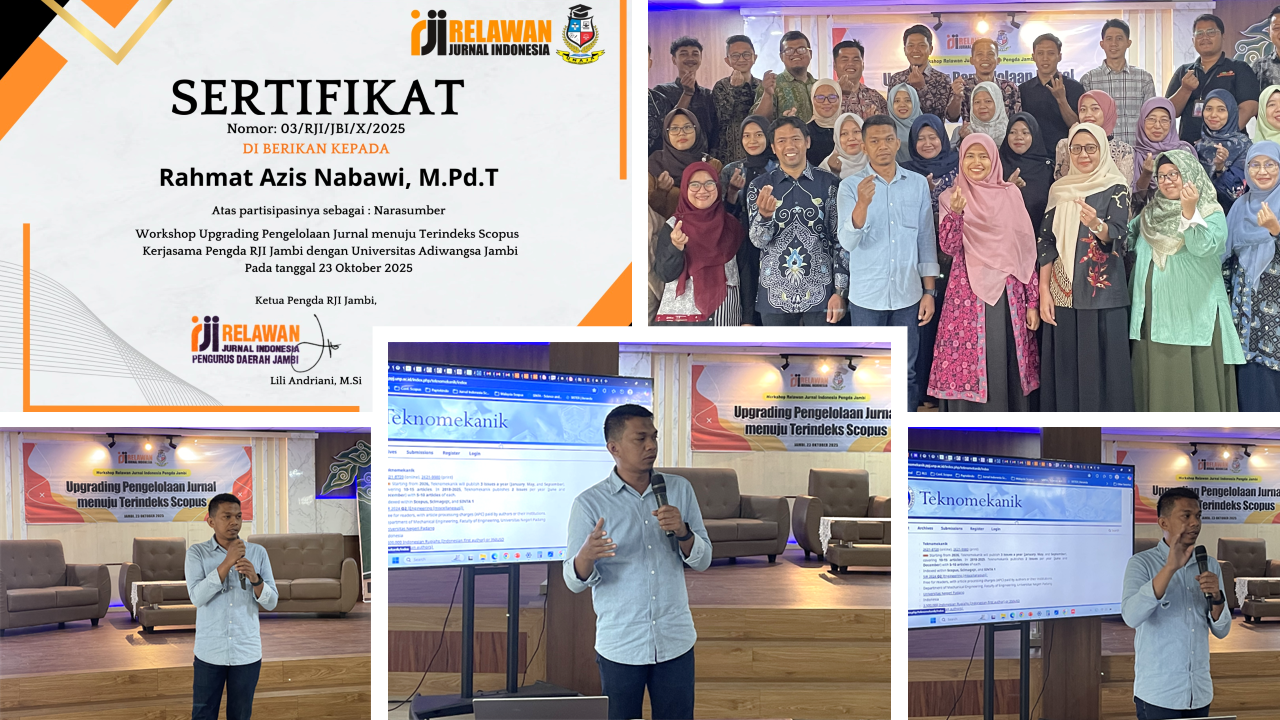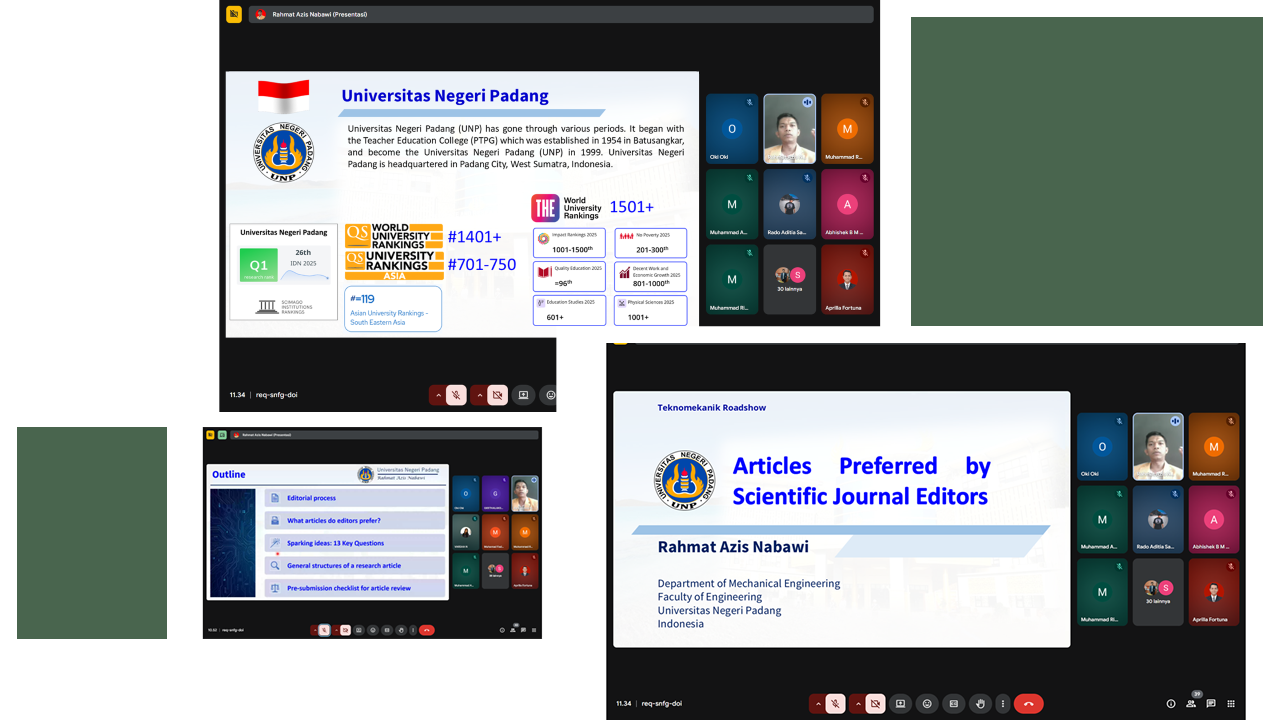The influence of processing temperature on the mechanical properties of recycled PET fibers
DOI:
https://doi.org/10.24036/teknomekanik.v6i1.21472Keywords:
PET waste, recycled PET fibers, mechanical properties, recycling, processing temperaturesAbstract
Study towards the recycling of PET waste has arisen in the last decades. One of the most widely used methods was the mechanical recycling process due to its simplicity and low cost of production. In this research, PET waste obtained from the disposable water gallon containers was used to produce recycled PET fibers for textile applications. The PET fibers were prepared using the extrusion technique by varying the processing temperatures, i.e., 200, 210, 220, 230, and 240°C. The diameter, FTIR analysis, XRD analysis, and mechanical properties of the PET fibers at various processing temperatures were studied. The results showed that the optimum processing temperature for preparing recycled PET fibers was 210°C with a diameter of 0.23 mm, a degree of crystallinity of 8.9%, a tensile strength of 70.4 MPa, and an elongation at break of 83.6%. In conclusion, PET waste shows a promising application to be processed as recycled PET fibers for textile applications.
Downloads
References
L. W. McKeen, “Polyester Plastics,” in Permeability Properties of Plastics and Elastomers, William Andrew Publishing, 2017. https://doi.org/10.1016/B978-0-323-50859-9/00006-3
S. Mandal and A. Dey, “PET Chemistry,” Recycling of Polyethylene Terephthalate Bottles, pp. 1–22, 2019. https://doi.org/10.1016/b978-0-12-811361-5.00001-8
M. N. Rao, R. Sultana, and S. H. Kota, “Plastic Waste,” in Solid and Hazardous Waste Management, 2017, pp. 121–126. https://doi.org/10.1016/b978-0-12-809734-2.00003-1
R. Nisticò, “Polyethylene terephthalate (PET) in the packaging industry,” Polymer Testing, vol. 90, no. July, 2020. https://doi.org/10.1016/j.polymertesting.2020.106707
F. Awaja and D. Pavel, “Recycling of PET,” European Polymer Journal, vol. 41, no. 7, pp. 1453–1477, 2005. https://doi.org/10.1016/j.eurpolymj.2005.02.005
A. Rane, A. R. Ajitha, M. K. Aswathi, P. Manju, K. Kanny, and S. Thomas, “Applications of Waste Poly(Ethylene Terephthalate) Bottles,” Recycling of Polyethylene Terephthalate Bottles, pp. 169–189, 2019. https://doi.org/10.1016/b978-0-12-811361-5.00009-2
E. Langer, K. Bortel, S. Waskiewicz, and M. Lenartowicz-Klik, Methods of PET Recycling. 2020. https://doi.org/10.1016/b978-0-323-46200-6.00005-2
R. Tang et al., “Preparation and performance analysis of recycled PET fiber reinforced recycled foamed concrete,” Journal of Building Engineering, vol. 57, no. April, p. 104948, 2022. https://doi.org/10.1016/j.jobe.2022.104948
A. D. Le, R. Gilblas, V. Lucin, Y. Le Maoult, and F. Schmidt, “Infrared heating modeling of recycled PET preforms in injection stretch blow molding process,” International Journal of Thermal Sciences, vol. 181, no. April, p. 107762, 2022. https://doi.org/10.1016/j.ijthermalsci.2022.107762
S. Afgan et al., “High strength insulating polymeric composite based on recycled/virgin polyethylene terephthalate (PET) reinforced with hydrous magnesium silicate (talc),” Journal of Materials Research and Technology, vol. 21, pp. 3579–3593, 2022. https://doi.org/10.1016/j.jmrt.2022.10.126
M. J. Chinchillas-Chinchillas et al., “A new application of recycled-PET/PAN composite nanofibers to cement–based materials,” Journal of Cleaner Production, vol. 252, 2020. https://doi.org/10.1016/j.jclepro.2019.119827
M. Khashij, M. Mokhtari, A. Dalvand, F. Haghiralsadat, H. Fallahzadeh, and M. Hossein Salmani, “Recycled PET/metal oxides nanocomposite membrane for treatment of real industrial effluents: Membrane fabrication, stability, antifouling behavior, and process modeling and optimization,” Journal of Molecular Liquids, vol. 364, p. 119966, 2022. https://doi.org/10.1016/j.molliq.2022.119966
R. P. de Oliveira Santos, L. A. Ramos, and E. Frollini, “Bio-based electrospun mats composed of aligned and nonaligned fibers from cellulose nanocrystals, castor oil, and recycled PET,” International Journal of Biological Macromolecules, vol. 163, pp. 878–887, 2020. https://doi.org/10.1016/j.ijbiomac.2020.07.064
M. K. J. E. Exconde, J. A. A. Co, J. Z. Manapat, and E. R. Magdaluyo, “Materials selection of 3D printing filament and utilization of recycled polyethylene terephthalate (PET) in a redesigned breadboard,” Procedia CIRP, vol. 84, pp. 28–32, 2019. https://doi.org/10.1016/j.procir.2019.04.337
X.-C. HU and H. H. YANG, “Polyamide and Polyester Fibers,” in Comprehensive Composite Materials, A. Kelly and C. Zweben, Eds., Pergamon, 2000, pp. 327–344. https://doi.org/10.1016/b0-08-042993-9/00060-7
J. C. Tapia-Picazo, J. G. Luna-Bárcenas, A. García-Chávez, R. Gonzalez-Nuñez, A. Bonilla-Petriciolet, and A. Alvarez-Castillo, “Polyester fiber production using virgin and recycled PET,” Fibers and Polymers, vol. 15, no. 3, pp. 547–552, 2014. https://doi.org/10.1007/s12221-014-0547-7
E. Sarioğlu, S. Nohut, D. Vuruşkan, and O. Yayla, “Production and characterization of recycled polyester (r-PET) blend vortex and ring spun yarns,” Journal of the Textile Institute, vol. 111, no. 12, pp. 1705–1712, 2020. https://doi.org/10.1080/00405000.2020.1720360
M. Abbasi and R. Kotek, “Effects of drawing process on crimp formation-ability of side-by-side bicomponent filament yarns produced from recycled, fiber-grade and bottle-grade PET,” Journal of the Textile Institute, vol. 110, no. 10, pp. 1439–1444, 2019. https://doi.org/10.1080/00405000.2019.1611523
B. Esi and P. D. Baykal, “Investigation of tensile strength and elongation properties of chenille upholstery fabrics including recycling polyester yarns,” Journal of Engineered Fibers and Fabrics, vol. 15, pp. 1–10, 2020. https://doi.org/10.1177/1558925020916040
J. Jonzon, “Characterization and modeling of amorphous and crystalline ratios in poly-acrylates,” Mid Sweden University, 2020.
C. Sirisinha, “A review of extrudate swell in polymers,” J. Sci. Soc. Thailand, vol. 23, pp. 259–280, 1997. https://doi.org/10.2306/scienceasia1513-1874.1997.23.259
J. Z. Liang, “Effects of extrusion conditions on die-swell behavior of polypropylene/diatomite composite melts,” Polymer Testing, vol. 27, no. 8, pp. 936–940, 2008. https://doi.org/10.1016/j.polymertesting.2008.08.001
M. Mecozzi and L. Nisini, “The differentiation of biodegradable and non-biodegradable polyethylene terephthalate (PET) samples by FTIR spectroscopy: A potential support for the structural differentiation of PET in environmental analysis,” Infrared Physics and Technology, vol. 101, no. May, pp. 119–126, 2019. https://doi.org/10.1016/j.infrared.2019.06.008
H. Asadi, J. Uhlemann, N. Stranghoener, and M. Ulbricht, “Artificial weathering mechanisms of uncoated structural polyethylene terephthalate fabrics with focus on tensile strength degradation,” Materials, vol. 14, no. 3, pp. 1–24, 2021. https://doi.org/10.3390/ma14030618
B. T. I. Ali, N. Widiastuti, Y. Kusumawati, and J. Jaafar, “Utilization of polyethylene terephthalate (PET) plastic bottle waste as membrane with several modifications for the removal of chromium ions in wastewater,” Materials Today: Proceedings, no. xxxx, 2022. https://doi.org/10.1016/j.matpr.2022.11.141
I. N. Strain, Q. Wu, A. M. Pourrahimi, M. S. Hedenqvist, R. T. Olsson, and R. L. Andersson, “Electrospinning of recycled PET to generate tough mesomorphic fibre membranes for smoke filtration,” Journal of Materials Chemistry A, vol. 3, no. 4, pp. 1632–1640, 2015. https://doi.org/10.1039/c4ta06191h

Downloads
Published
Issue
Section
License
Copyright (c) 2023 Anna Niska Fauza, Fitrah Qalbina, Hendri Nurdin, Ambiyar Ambiyar, Refdinal Refdinal (Author)

This work is licensed under a Creative Commons Attribution 4.0 International License.






